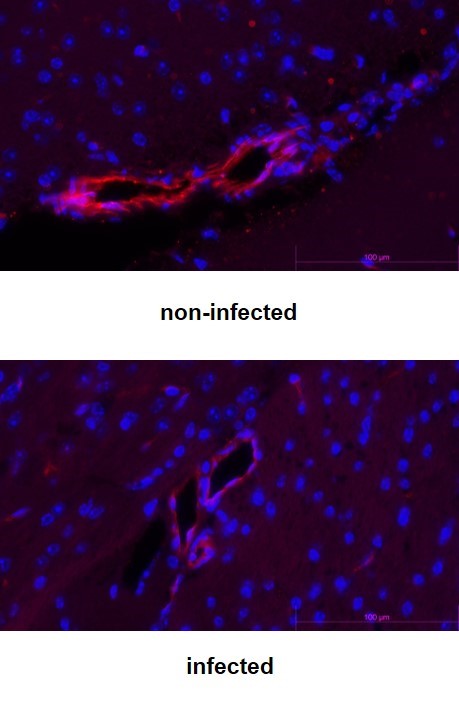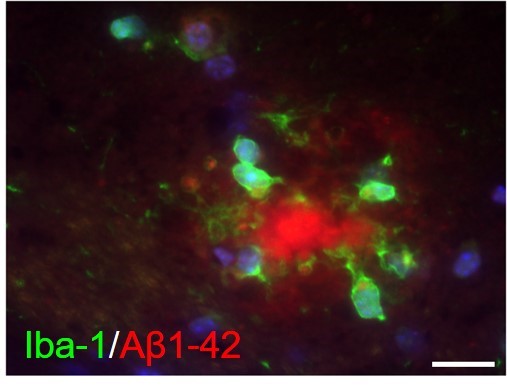AG Brandenburg
Scientific profile
The immune response in the Central nervous system (CNS) is mediated especially by blood-brain-barrier and resident immune cells. The resident immune cells of the CNS, the glial cells, are the microglial cells and astrocytes which exert multiple functions in the CNS, including protective and restorative responses to CNS infection or injury. The microglial cells as the macrophages as an important part of the innate immunity of the CNS are responsible for the detection and phagocytosis of the pathogens. They are involved in the antigen presentation and control the immune response in the CNS. Astrocytes belong to the macroglia of the brain. They participate in the formation and maintenance of the blood-brain-barrier and are involved in the envelopment and isolation of the synapsis. In addition, they are important for the maintenance of the ion balance and homostasis in the brain.
The immune cells including the glial cells are able to recognize an infinite antigenic repertoire of broadly defined molecular motifs from pathogens. These molecular determinants, termed PAMPs (pathogen associated molecular patterns), are conserved pattern which are sensed by PRRs (pattern recognition receptors), which comprise multiple receptor families located in both the extracellular and intracellular milieus. In addition to detecting molecular patterns associated with many micro-organisms, PRRs have also been implicated in recognizing an array of endogenous molecules termed DAMPs (danger-associated molecular patterns). The PRR include receptor families such as the Toll like receptors (TLR), or the formyl peptide receptors (FPR) or the intracellular nucleotide-binding oligomerization domain-like receptors (NOD).
In the focus of our research are the FPR and their role in the innate immune response of the CNS. The FPR are chemotactic G protein coupled receptor. The murine FPR gene family has at least six members in contrast to only three in humans. The two most important members are the Fpr1 and Fpr2. Fpr1 encodes murine Fpr1, which is considered the murine orthologue of human FPR, whereas Fpr-rs2 (mFPR2) encodes a receptor that is most similar to human formyl peptide receptor like 1 (FPRL1) or FPR2. The FPR detect PAMPs such as fMLF from the bacterial cell wall. For example, DAMPs are intracellular molecules such as mitochondrial fMLF. Interestingly, the FPR members show a wide range of pro- and anti-inflammatory ligands. It is known that the receptor interacts with a menagerie of structurally diverse ligands associated with different neurodegenerative disorders, including Alzheimer’s and prion disease.
In the context of the role of the FPR in the inflammation in the CNS, we are focused on the one side on the acute inflammation in form of the bacterial meningitis. We investigated the influence of the FPR and their pro- or anti-inflammatory ligands on the course of bacterial meningitis. We are interested in the acute response and the neuroregeneration after the healing of the disease. We are looking at the influence of the different FPR ligands on the integrity of the BBB and the bacterial distribution in the course of the infection in the brain. On the other hand, We are interested on chronic/degenerative inflammation. Therefore, we investigate in different projects the role of the FPR in the inflammation in the Alzheimer disease and Multiple Sclerosis.



Most important publications
Rüger, M., Kipp, E., Schubert, N., Schröder. N., Pufe, T., Stope M.B., Kipp, E., Blume, C., Tauber, S.C., Brandenburg, L.O. (2020) The Formyl peptide receptor agonist Ac2-26 alleviates neuroinflammation in a mouse model of pneumococcal meningitis. J Neuroinflammation. 17, 325.
Schröder. N., Schaffrath, A., Welter, J.A., Putzka, T., Griep, A., Ziegler, P., Brandt, E., Samer, S., Heneka, M.T., Kaddatz, H., Zhan, J., Kipp, E., Pufe, T., Tauber, S.C., Kipp, M., Brandenburg, L.O. (2020) Inhibition of formyl peptide receptors improves the outcome in a mouse model of Alzheimer disease. J Neuroinflammation. 17, 131.
Esser, S., Göpfrich, L., Bihler, K., Kress, E., Nyamoya, S., Tauber, S.C., Clarner, T., Stope, M.B., Pufe, T., Kipp, M., Brandenburg, L.O. (2018) Toll-like receptor 2 mediated glial cell activation in a mouse model of cuprizone-induced demyelination. Mol. Neurobiol. 55, 6237-6249.
Kress, E., Merres, J., Albrecht, L.J., Hammerschmidt, S., Pufe, T., Tauber, S.C., Brandenburg, L.O. (2017) CRAMP deficiency leads to a pro-inflammatory phenotype and impaired phagocytosis after exposure to bacterial meningitis pathogens. Cell Commun Signal. 15, 32.
Oldekamp, S., Pscheidl, S., Kress, E., Soehnlein, O., Jansen, S., Pufe, T., Wang, J.M., Tauber, S.C., Brandenburg, L.O. (2014) Lack of formyl peptide receptor 1 and 2 leads to more severe inflammation and higher mortality in mice with of pneumococcal meningitis. Immunology. 143, 447-461.
Merres, J., Höß, J., Albrecht, L.J., Kress, E., Soehnlein, O., Jansen, S., Pufe, T., Tauber, S.C., Brandenburg, L.O. (2014) The role of antimicrobial peptide CRAMP in inflammation and mortality in a mouse model of bacterial meningitis. J. Innate Immun. 6, 205-218.
Slowik, A., Merres, J., Elfgen, A., Jansen, S., Mohr, F., Wruck, C.J., Pufe, T., Brandenburg, L.O. (2012) Involvement of formyl peptide receptors in receptor for advanced glycation end products (RAGE) - and amyloid beta 1-42-induced signal transduction in glial cell. Mol. Neurodegeneration. 7, 55.
Braun, B.J., Slowik, A., Leib, S.L., Lucius, R., Varoga, D., Wruck, C.J., Jansen, S., Podschun, R., Pufe, T., Brandenburg, L.O. (2011) The formyl peptide receptor like-1 and scavenger receptor MARCO are involved in glial cell activation in bacterial meningitis. J Neuroinflammation. 8, 11.
Brandenburg, L.O., Konrad, M., Wruck, C.J., Koch, T., Lucius, R. and Pufe, T. (2010) Functional and physical interactions between Formyl-Peptide-Receptors and Scavenger Receptor MARCO and their involvement in Amyloid beta 1-42 (Aβ1-42)-induced signal transduction in Glial Cells. J. Neurochem. 113, 749-760.
Brandenburg, L.O., Varoga, D., Nicolaeva, N., Leib, S.L., Wilms, H., Podschun, R., Wruck, C.J., Schroeder, J.M., Pufe, T. and Lucius, R. (2008) Role of glial cells in the functional expression of the antimicrobial peptide LL-37/rCRAMP in meningitis. J. Neuropathol. Exp. Neurol. 67, 1041-54.
Fundings
DFG (Brandenburg)„Untersuchungen zur immunmodulatorischen und neuroregenerativen Rolle der Formyl-Peptid-Rezeptoren nach der bakteriellen Meningitis“
